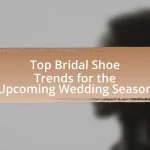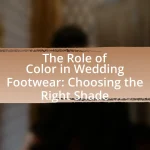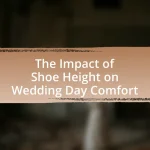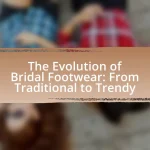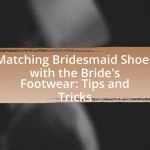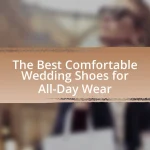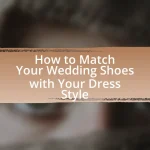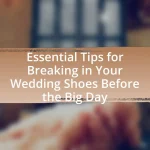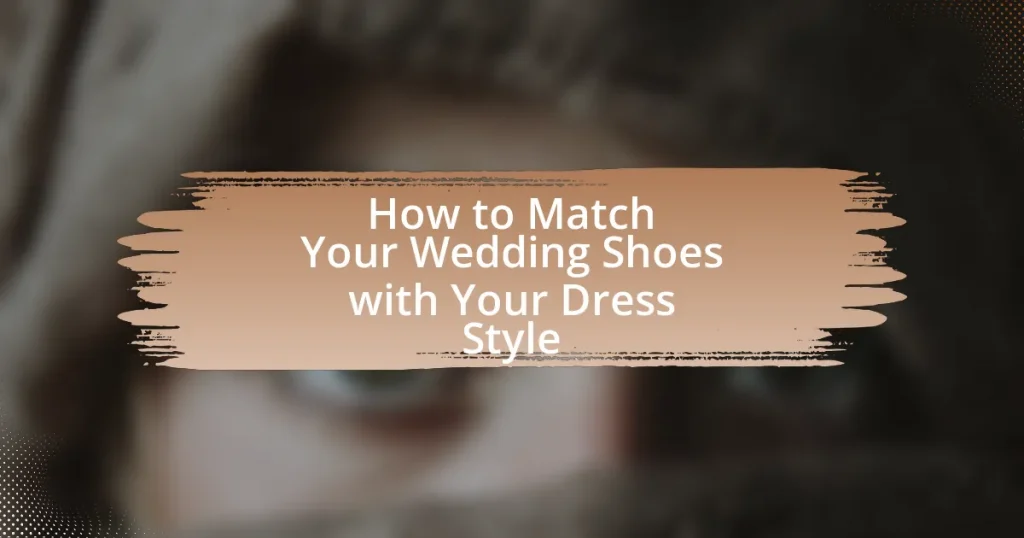The article focuses on how to effectively match wedding shoes with dress styles, emphasizing the importance of considering dress silhouette, length, color, and material. It outlines key factors such as the influence of the wedding theme, the variety of shoe types available, and the significance of comfort in shoe selection. Additionally, it discusses how to coordinate shoe color with different dress shades, the role of accessories, and common mistakes to avoid when making shoe choices. The article provides practical tips for ensuring a proper fit and comfort, ultimately guiding brides to achieve a cohesive and stylish look on their wedding day.

How do you choose the right wedding shoes for your dress style?
To choose the right wedding shoes for your dress style, first consider the silhouette and length of your dress. For example, if you have a ball gown, opt for heels that enhance the volume, while a sheath dress pairs well with sleek, minimalist shoes. Additionally, the color and fabric of the shoes should complement the dress; for instance, metallic or nude shades can elongate the legs and match various styles. The heel height must also align with your comfort and the dress’s hemline to ensure a balanced look. According to bridal fashion experts, the right shoe can elevate the overall aesthetic, making it essential to align the shoe choice with the dress’s design elements.
What factors should you consider when matching shoes to your dress?
When matching shoes to your dress, consider color, style, material, and occasion. Color coordination is crucial; shoes should either match the dress or complement it through contrasting shades. The style of the shoes must align with the dress’s formality; for instance, elegant heels suit formal gowns, while flats may be appropriate for casual dresses. Material also plays a significant role; leather shoes may not pair well with a flowy fabric dress, while satin shoes can enhance a silk gown. Lastly, the occasion dictates the shoe choice; outdoor weddings may require more practical footwear compared to indoor ceremonies.
How does the dress silhouette influence shoe selection?
The dress silhouette significantly influences shoe selection by determining the overall aesthetic and proportion of the outfit. For instance, a fitted mermaid gown typically pairs well with sleek, pointed-toe heels to elongate the legs, while a flowing A-line dress may be complemented by block heels or wedges for stability and comfort. This alignment ensures that the shoes enhance the dress’s shape and maintain visual harmony. Studies in fashion design emphasize that the right shoe can accentuate the dress’s lines, creating a cohesive look that flatters the wearer.
What role does the wedding theme play in shoe choice?
The wedding theme significantly influences shoe choice by dictating the style, color, and overall aesthetic that complements the event. For instance, a rustic wedding theme may call for more casual, earthy-toned shoes, while a formal black-tie wedding typically requires elegant heels or polished dress shoes. This alignment ensures that the footwear harmonizes with the overall decor and attire, enhancing the visual coherence of the wedding. Studies in fashion psychology indicate that cohesive styling can enhance the perceived beauty of an outfit, reinforcing the importance of matching shoes to the wedding theme.
What types of wedding shoes are available?
Various types of wedding shoes are available, including heels, flats, sandals, boots, and sneakers. Heels, such as stilettos and block heels, offer elegance and height, while flats provide comfort and ease of movement. Sandals can be stylish and breathable, suitable for outdoor weddings, whereas boots can add a unique touch, especially for rustic or winter weddings. Sneakers are increasingly popular for brides seeking comfort and a modern twist. Each type caters to different styles and preferences, ensuring that brides can find the perfect match for their wedding dress.
What are the differences between heels, flats, and sandals?
Heels, flats, and sandals differ primarily in their design, height, and intended use. Heels elevate the foot, often enhancing posture and leg appearance, and are typically worn for formal occasions, including weddings. Flats provide a level sole without elevation, offering comfort and practicality, making them suitable for casual or relaxed settings. Sandals feature open designs, allowing breathability and are versatile for both casual and semi-formal events. Each type serves distinct purposes, with heels often associated with elegance, flats with comfort, and sandals with casual style.
How do different materials affect shoe selection?
Different materials significantly influence shoe selection by affecting comfort, durability, breathability, and style compatibility. For instance, leather shoes offer durability and a classic aesthetic, making them suitable for formal wedding settings. In contrast, satin or silk materials provide a more delicate and elegant look, aligning well with romantic dress styles. Additionally, breathable materials like mesh enhance comfort for outdoor weddings, while synthetic options may offer a more affordable choice without compromising style. The choice of material directly impacts how well the shoes complement the wedding dress, ensuring a cohesive and stylish appearance.
Why is comfort important when selecting wedding shoes?
Comfort is crucial when selecting wedding shoes because it directly impacts the wearer’s ability to enjoy the event without physical discomfort. Weddings often involve long hours of standing, walking, and dancing, making it essential for shoes to provide adequate support and cushioning. Research indicates that discomfort from footwear can lead to fatigue and distraction, which detracts from the overall experience of the day. Therefore, prioritizing comfort ensures that the bride can focus on her celebration rather than on her feet.
How can you ensure your shoes are comfortable for the big day?
To ensure your shoes are comfortable for the big day, select shoes that fit well and provide adequate support. Proper sizing is crucial; shoes should not be too tight or too loose, as this can lead to discomfort. Additionally, consider the shoe’s material and cushioning; soft, breathable materials and ample padding can enhance comfort during extended wear. Research indicates that wearing shoes with a lower heel height can reduce foot strain, making them more comfortable for long periods (American Podiatric Medical Association).
What are some tips for breaking in wedding shoes?
To break in wedding shoes effectively, wear them around your home for short periods to gradually soften the material. This method allows the shoes to conform to your feet without causing discomfort. Additionally, consider using thick socks while walking in the shoes to stretch them further. Applying a leather conditioner can also help soften stiff materials, making them more comfortable. According to footwear experts, breaking in shoes this way can reduce the risk of blisters and discomfort on the wedding day.
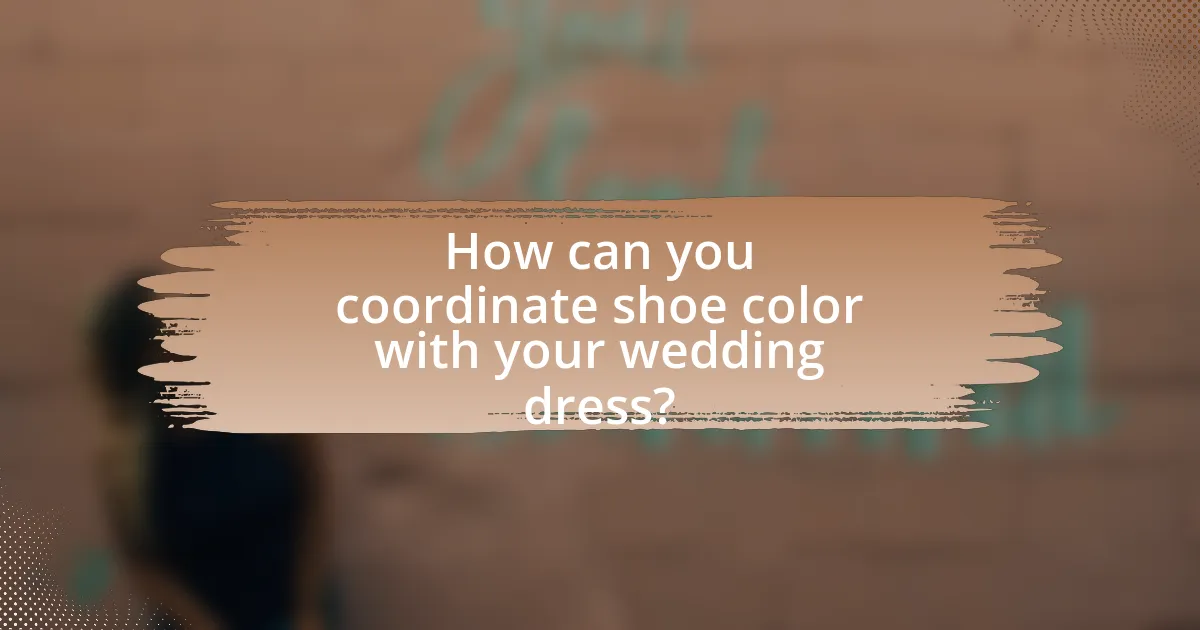
How can you coordinate shoe color with your wedding dress?
To coordinate shoe color with your wedding dress, select a hue that complements or contrasts with the dress color. For instance, if the wedding dress is white or ivory, classic options include silver, gold, or nude shoes, which enhance the overall look without overwhelming it. Alternatively, for a bolder statement, choose shoes in a vibrant color that matches the wedding theme or floral arrangements, creating a cohesive aesthetic. This approach is supported by fashion guidelines that emphasize color harmony and contrast to achieve a balanced visual appeal.
What color options work best with different dress shades?
White dresses pair well with silver, gold, or nude shoes for a classic look. Light pastel dresses, such as blush or mint, complement shoes in soft metallics or neutral tones. Bold colors like red or royal blue work best with black, white, or metallic shoes to create a striking contrast. Darker shades, such as navy or burgundy, can be paired with rich jewel tones or metallics for an elegant appearance. These combinations enhance the overall aesthetic and maintain harmony in the outfit.
How do neutral colors enhance various dress styles?
Neutral colors enhance various dress styles by providing versatility and a timeless appeal that complements a wide range of designs. These colors, such as beige, gray, and taupe, serve as a neutral backdrop, allowing the dress’s silhouette and details to stand out without overwhelming the overall look. For instance, a neutral-colored dress can be paired effortlessly with vibrant accessories or shoes, creating a balanced aesthetic. Additionally, neutral tones are often associated with elegance and sophistication, making them a popular choice for formal occasions, including weddings. Studies in fashion psychology indicate that neutral colors evoke feelings of calmness and stability, further enhancing the wearer’s confidence and poise.
What are the benefits of choosing bold colors for shoes?
Choosing bold colors for shoes enhances visual impact and personal expression. Bold colors can create a striking contrast with wedding dresses, making the footwear a focal point of the outfit. This choice allows individuals to showcase their personality and style, contributing to a unique and memorable look. Additionally, bold-colored shoes can complement or accentuate specific elements of the wedding attire, such as floral arrangements or color themes, thereby creating a cohesive aesthetic. Studies in fashion psychology indicate that vibrant colors can evoke positive emotions and confidence, further enhancing the overall experience of the event.
How can accessories complement your shoe choice?
Accessories can enhance your shoe choice by creating a cohesive look that ties together your overall outfit. For instance, matching your handbag or jewelry to the color or style of your shoes can create visual harmony, making the ensemble appear more intentional. Studies in fashion psychology indicate that coordinated accessories can elevate perceived style and sophistication, reinforcing the idea that thoughtful pairing enhances aesthetic appeal.
What types of accessories should you consider pairing with your shoes?
Consider pairing your wedding shoes with accessories such as handbags, jewelry, and hosiery. Handbags complement the overall look and can match the shoe color or style, enhancing the outfit’s cohesion. Jewelry, including earrings and bracelets, can add elegance and draw attention to the shoes, especially if they feature similar design elements. Hosiery, such as tights or stockings, can also be chosen to match or contrast with the shoes, contributing to the overall aesthetic. These accessories not only complete the outfit but also ensure a harmonious appearance on your wedding day.
How do jewelry and shoe styles work together?
Jewelry and shoe styles work together by creating a cohesive look that enhances the overall outfit. When selecting wedding shoes, the style of jewelry should complement the shoe design, color, and embellishments. For instance, if the shoes feature intricate details like beading or lace, the jewelry should be simpler to avoid overwhelming the ensemble. Conversely, if the shoes are minimalist, statement jewelry can add a focal point. This coordination is essential for achieving a balanced aesthetic, as mismatched styles can detract from the overall elegance of the wedding attire.
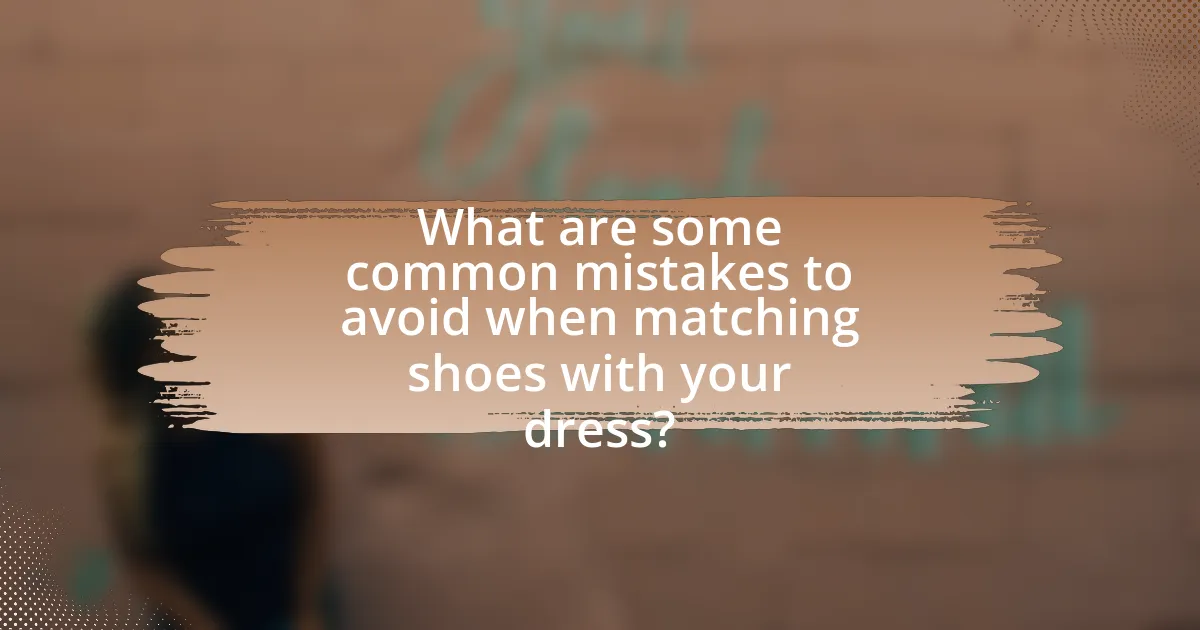
What are some common mistakes to avoid when matching shoes with your dress?
Common mistakes to avoid when matching shoes with your dress include choosing shoes that clash with the dress color, failing to consider the dress style, and neglecting comfort. Selecting shoes in a color that does not complement the dress can create a disjointed look; for example, pairing a soft pastel dress with bright neon shoes can be visually jarring. Additionally, mismatching the shoe style with the dress type, such as wearing casual sneakers with a formal gown, can undermine the overall elegance of the outfit. Lastly, prioritizing style over comfort can lead to discomfort during the event, which is particularly important for occasions like weddings where long hours are spent standing or dancing.
What are the pitfalls of prioritizing style over comfort?
Prioritizing style over comfort can lead to significant physical discomfort and potential long-term health issues. When individuals choose fashionable shoes that lack proper support or fit, they may experience pain, blisters, or even conditions like plantar fasciitis. Research indicates that wearing ill-fitting shoes can contribute to foot deformities and chronic pain, as highlighted in a study published in the Journal of Foot and Ankle Research, which found that 70% of participants reported foot pain related to shoe choice. Additionally, discomfort can detract from the overall experience, making it difficult to enjoy events such as weddings, where prolonged standing and walking are common.
How can mismatched styles detract from your overall look?
Mismatched styles can detract from your overall look by creating visual dissonance that disrupts the harmony of your outfit. When elements such as shoes and dress styles do not complement each other, it can lead to an uncoordinated appearance that draws attention away from the intended aesthetic. For example, pairing formal wedding shoes with a casual dress can confuse the viewer’s perception of the outfit’s formality, resulting in a less polished look. Studies in fashion psychology indicate that cohesive styling enhances perceived attractiveness and confidence, reinforcing the importance of matching styles for a cohesive overall appearance.
What should you avoid when selecting shoe height?
When selecting shoe height, you should avoid choosing a height that does not complement your dress style. Selecting shoes that are too high can create an imbalance with the dress, especially if the dress has a long train or is floor-length, leading to tripping hazards. Additionally, avoid selecting a shoe height that does not provide adequate comfort for prolonged wear, as discomfort can detract from your overall experience on your wedding day.
How can you ensure your shoes fit well on your wedding day?
To ensure your shoes fit well on your wedding day, you should try them on with the same type of hosiery or socks you plan to wear and walk around in them for at least 30 minutes. This practice allows you to assess comfort and fit accurately, as shoes can feel different after extended wear. Additionally, consider purchasing shoes in the afternoon or evening when your feet are slightly swollen, which helps in selecting a size that accommodates natural foot changes throughout the day. According to a study by the American Podiatric Medical Association, proper shoe fit is crucial for foot health, especially during long events like weddings.
What are the best practices for shoe fitting before the wedding?
The best practices for shoe fitting before the wedding include trying on shoes at the end of the day when feet are slightly swollen, ensuring a proper fit by checking for a thumb’s width of space between the longest toe and the shoe’s end, and wearing the same type of hosiery or socks that will be worn on the wedding day. Additionally, walking around in the shoes for at least 10-15 minutes helps assess comfort and fit. These practices are supported by the fact that feet can change size throughout the day, and a proper fit is crucial for comfort during long events like weddings.
How can you adjust your shoe choice if your dress style changes?
To adjust your shoe choice when your dress style changes, select footwear that complements the new style while ensuring comfort and appropriateness for the occasion. For instance, if transitioning from a formal gown to a casual dress, opt for stylish flats or low-heeled sandals instead of high heels. This adjustment maintains the overall aesthetic and functionality of your outfit. Studies indicate that footwear significantly influences perceived style coherence; thus, aligning shoe choice with dress style enhances visual appeal and comfort.
What tips can help you finalize your wedding shoe selection?
To finalize your wedding shoe selection, prioritize comfort, style, and compatibility with your dress. Comfort is crucial since you will be on your feet for extended periods; choose shoes that fit well and provide adequate support. Style should align with your dress’s design, whether it’s formal, casual, or bohemian, ensuring a cohesive look. Compatibility involves considering the dress length and fabric; for example, if you have a long gown, opt for shoes that won’t be visible, while a shorter dress allows for more creativity in shoe choice. These factors are essential for achieving a harmonious and comfortable wedding day experience.
